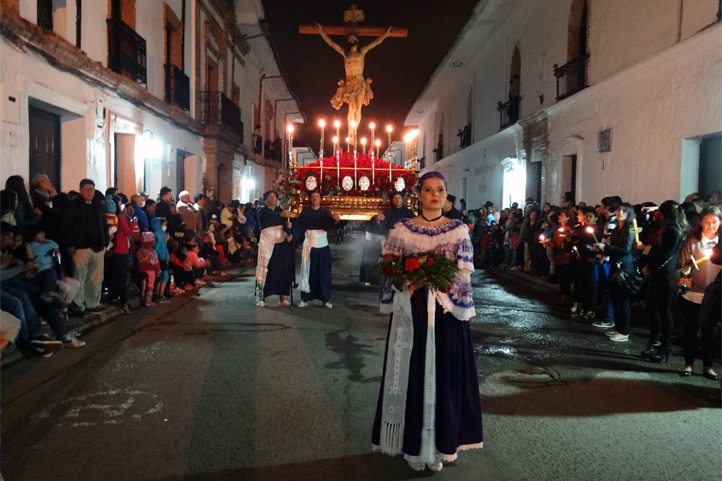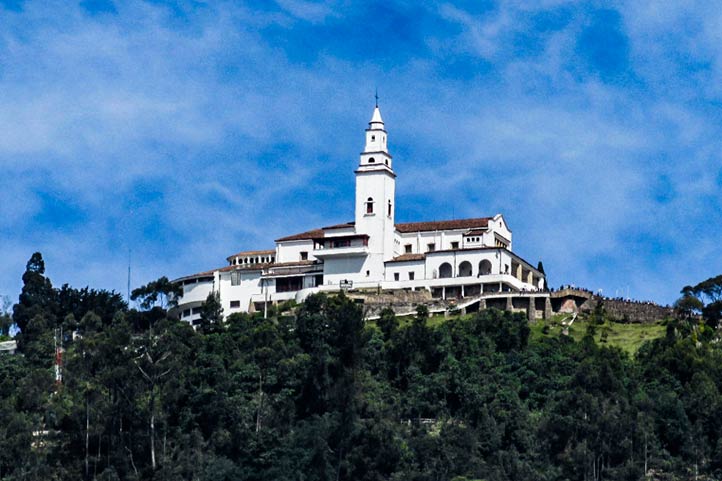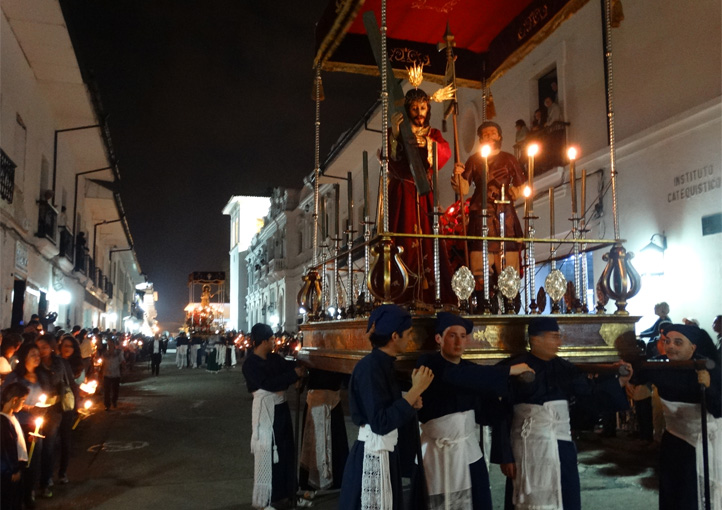Updated on 03/11/2024
Dear reader,
I would also like to recommend our Colombia travel guide, which provides a perfect overview of the tourist attractions in Colombia. Enjoy reading it!
Holy Week in Colombia is a deeply rooted religious celebration that combines faith, tradition, and culture. From Palm Sunday to Easter Sunday, the streets of Colombian cities and towns are filled with processions, religious representations, and liturgical events that commemorate the passion, death, and resurrection of Jesus Christ.
In this blog, we will share with you the activities that Colombian faithful engage in during this week, their customs and traditions, and the cities that stand out the most for their celebrations.
Content
Why is Holy Week so important in Colombia?
Holy Week plays a special role in the Colombian identity due to the influence of Catholicism in its cultural formation, driven by the Spanish conquest. From a spiritual perspective, it is a time of reflection on the relationship with God, repentance and the significant death and resurrection of Jesus. Culturally, events such as processions and rituals reflect good faith and connection with the divine.
From a cultural point of view, processions, rituals and participation in liturgical activities are manifestations of devotion and connection with the divine.
Daily Observances of Holy Week in Colombia and their customs
Holy Week is celebrated in the last week of March, specifically on the last Sunday of the month. It also includes rituals that take place before and during the eight days. Some of these are:
Lent
Holy Week begins with Lent, 40 days of fasting and penance commemorating the days Jesus Christ spent in the desert. “Ash Wednesday” marks the beginning, when priests mark a cross of ashes on the foreheads of the faithful as a reminder of mortality and penance.
All over Colombia you can see countless Colombians with the cross on their foreheads on Ash Wednesday. Morning mass is usually attended in order to demonstrate the faith to the public.
Palm Sunday
This day commemorates the triumphal entry of Jesus into Jerusalem. The faithful carry branches with palm and olive leaves to the processions as a symbol of victory and triumph, and after being blessed, they take them to their homes as a sign of protection.
Holy Monday
Known as “Monday of Authority”, this day recalls the intervention of Jesus Christ in the temple, expelling the merchants and restoring religious authority.
During Holy Monday, Tuesday and Wednesday, there are no major celebrations and the priests wear purple during the Eucharistic celebrations because it shows contrition and repentance felt by the parishioners.
Holy Tuesday
“Controversy Tuesday” is the day on which Jesus announced his death to his apostles, as well as the future betrayal by Judas Iscariot. It also commemorates Jesus’ confrontations with religious leaders, marking a day of great emotional intensity.
Holy Wednesday
The “Wednesday of Betrayal” marks the negotiation of Judas Iscariot to betray Jesus and the emotional Last Supper, a moment of profound symbolization.
Holy Thursday
This day commemorates the Last Supper of Jesus with his apostles, the washing of feet and the prayer on the Mount of Olives. The day is divided into three moments: the Chrism Mass, the Evening Mass and the tour of the 7 monuments.
In the morning there is a Chrism Mass, led by a bishop who blesses the oils and oils. The Evening Mass is held in the afternoon and begins the Easter Triduum, which is the period from Thursday to Friday in which the death and resurrection of Jesus Christ is commemorated. Finally, at night the faithful visit 7 different churches and pray at their monuments.
Good Friday
Good Friday commemorates the crucifixion and death of Jesus Christ. From the Stations of the Cross to the sermon of the Seven Words, the day invites reflection on the passion of Christ.
In some cities, you will see crowds of people walking through the neighborhoods while praying the Stations of the Cross. In some regions of Colombia, the “Burning of Judas” takes place. A doll representing Judas Iscariot is made and burned as a symbolic act of rejection of betrayal.
Holy Saturday
Holy Saturday is the third day of the Easter Triduum and is a day of mourning in which no mass is celebrated and no processions are held. In the evening hours the Easter Vigil begins, which ends in the early morning of Easter Sunday.
Fire, the liturgy of the word and water are central elements in this celebration. People take candles and blessed bottles of water to their homes as a symbol of protection.
Easter Sunday
Easter Sunday marks the climax of Holy Week, celebrating the resurrection of Jesus. Ceremonies and processions such as the “Procession of the Gathering” symbolize the joy of the resurrection.
Colombian Customs During Holy Week
During Holy Week, the faithful observe certain customs to demonstrate fidelity, respect, and fear of God. The most popular ones include:
- Fish on Important Days: During Holy Thursday, Good Friday, and Holy Saturday, the consumption of red meat and pork is avoided at all costs. Instead, people eat fish and other types of food, such as legumes. Eating these meats on these days is considered disrespectful. In some regions, like the coast, people may consume meat from wild animals, such as iguanas, turtles, and caimans. However, this poses a significant problem as it affects the population balance of these species.
- No Parties and Alcohol: Parties and alcohol consumption are also prohibited during Holy Week, especially on Holy Thursday, Good Friday, and Holy Saturday, as they demonstrate a lack of respect for the death of Jesus and the mourning that takes place.
- Abstinence from Sexual Relations: Sexual relations are also considered a great disrespect during Holy Week and are frowned upon by the more religious. According to popular beliefs, couples engaging in relations during these days may become ‘attached’ to each other.
- Vacation During Holy Week: While not part of Catholic traditions of Holy Week, schools and some universities in the country have a break in their activities. For most students, the vacation lasts the entire week, but in work environments, only Thursday and Friday are given as days off since they are national holidays.
During these days, the faithful dedicate the week to a period of reflection and spiritual activity. On the other hand, some people take the opportunity to travel to other parts of Colombia and the world. Thus, Holy Week is considered a peak season for tourism.
Popular Places to Celebrate Holy Week in Colombia
Popayán
Popayán, known as the “White City,” boasts the country’s oldest Holy Week celebration, dating back to 1556. Renowned for processions covering 2 kilometers, it includes diverse musical and cultural groups honoring the Holy Cross, Holy Burial, Virgin Mary, and Resurrection.
Preparations by the Junta Pro Semana span a year, with peak activity on Fridays and Saturdays. Five processions occur from Tuesday onwards, declared Intangible Cultural Heritage of Humanity by UNESCO in 2009 and Cultural Heritage of the Nation in 2004.
During the silent processions, prayers sung in chorus create a solemn atmosphere, attracting those interested in religious tourism. The weighty floats, passed down through generations, weigh up to 600 kilograms and are carried by eight individuals, seen as an honorable duty.

The Religious Music Festival of Popayán, part of Holy Week, holds cultural significance, declared Cultural Heritage of the Nation in 2004 and recognized as one of the world’s oldest festivals of its kind due to its extensive history.
Mompox
This small city has one of the most colorful Holy Week celebrations in the country, heavily influenced by traditions from Seville, Spain, since colonial times.
The festivities begin on Palm Sunday, but it is on Holy Wednesday that the faithful conduct a procession in homage to their deceased, moving from the main streets to the cemetery. They also carry flowers and candles during these nighttime processions.
The processions include the participation of the most important religious figures of the town and feature Catholic musical groups.
Buga
Thousands of tourists flock to the city of Buga in the Valle del Cauca to participate in the religious activities of Holy Week, primarily to visit and venerate the image of the Miraculous Christ, located in the Basilica of the Lord of Miracles.
Inside the Basilica, there are images of other saints whom people visit to make supplications and requests, and masses are held throughout the day. Around the Basilica, various shops sell items like rosaries and images for blessings during the mass.
Nightly processions are also held, where the most important figures in Holy Week and images are paraded by the faithful.
Ipiales
The city of Ipiales is well-known for its Sanctuary of Las Lajas, attracting thousands of people, both Colombians and foreigners. Las Lajas is primarily appealing for its architecture, location on a cliff, and religious images.
The celebration of Holy Week in Ipiales was declared Intangible Cultural Heritage of the municipality in 2012. Pilgrimages are accompanied by sacred images carried by the faithful to be blessed.
Zipaquirá
The municipality of Zipaquirá in Cundinamarca is popular for the Salt Cathedral, known as the “First Colombian Wonder.” It is recognized as the only underground temple in the world and the second most impressive place of worship on the planet in 2017. This temple receives over 600,000 visitors annually.
The cathedral is 180 meters underground, and its surrounding structures are carved in salt. Among the tourist attractions is the Stations of the Cross route, covering 386 meters and featuring the 14 stages of Jesus’ crucifixion and death.
Bogotá
Despite the capital not being one of the most religious cities in Colombia, Bogotá is home to numerous temples where activities like processions and masses take place.
The Sanctuary of the Fallen Lord of Monserrate, located in the eastern hills, attracts thousands of faithful to its journey, masses, and to visit the statue of the fallen Jesus. Some believers have a tradition of climbing the 1,605 steps to the sanctuary barefoot or on their knees. This practice is for penance, forgiveness of sins, fulfillment of promises, soul purification, and renewal of faith.

The Primatial Cathedral of Colombia in Plaza de Bolívar is one of the most important churches in the country and is also highly visited.
Other places include the Sanctuary of the Divine Child, located in the 20th of July square, where many people participate in processions and masses. Around this church, similar to the Basilica of Buga, numerous shops sell religious items.
More about Colombia Culture and Events
Explore Colombia’s culture by browsing our blogs.
- The 45 Best and Biggest Festivals in Colombia
- What Language is Spoken in Colombia? – Colombian Language Guide
- Colombian Dialects and Jargons – Guide to Colombian Words for Foreigners
- 31 Typical Colombian Dishes from All Regions You Should Try
- Discover What is the Main Religion in Colombia and its Cultural Impact
- How Easter is Celebrated in Colombia: Traditions and Emblematic Destinations
- Guide to Visiting Churches in Colombia: Manners and Tips for Tourists
- 28 Colombian Brands You Should Know When Visiting Colombia
- The Scariest Places You Can Find in Colombia
- The 7 Most Terrifying Legends in Colombia
- 5 Incredible Indigenous Communities Still Existing in Colombia
- 17 Master Colombian Artisans You Must Know
- Top 9 UNESCO World Heritage Sites in Colombia
- Curious Facts about the 14 Most Important Monuments in Colombia
- Top 12 Most Important Olympic Athletes in Colombia
- Top 10 Colombia Travel Influencers to Follow on Networks
- 24 Powerful Colombian Natural Remedies for Common Ailments
- How is New Year’s Eve Celebrated in Colombia? 15 Traditions You Should Know
- Guide to Colombian Manners and Etiquette Rules for Foreigners in Colombia
- All About Graffiti and Urban Art in Colombia

